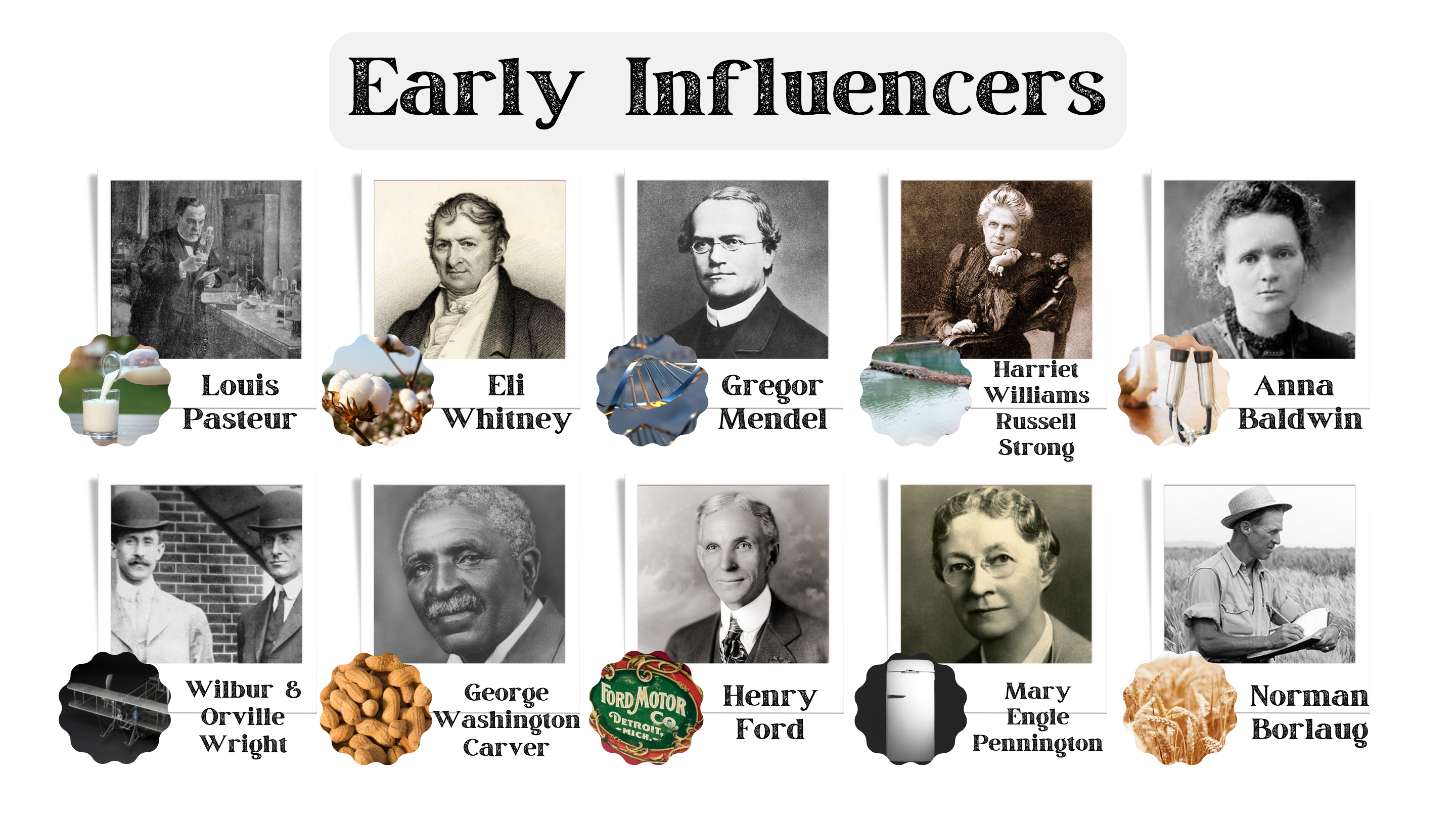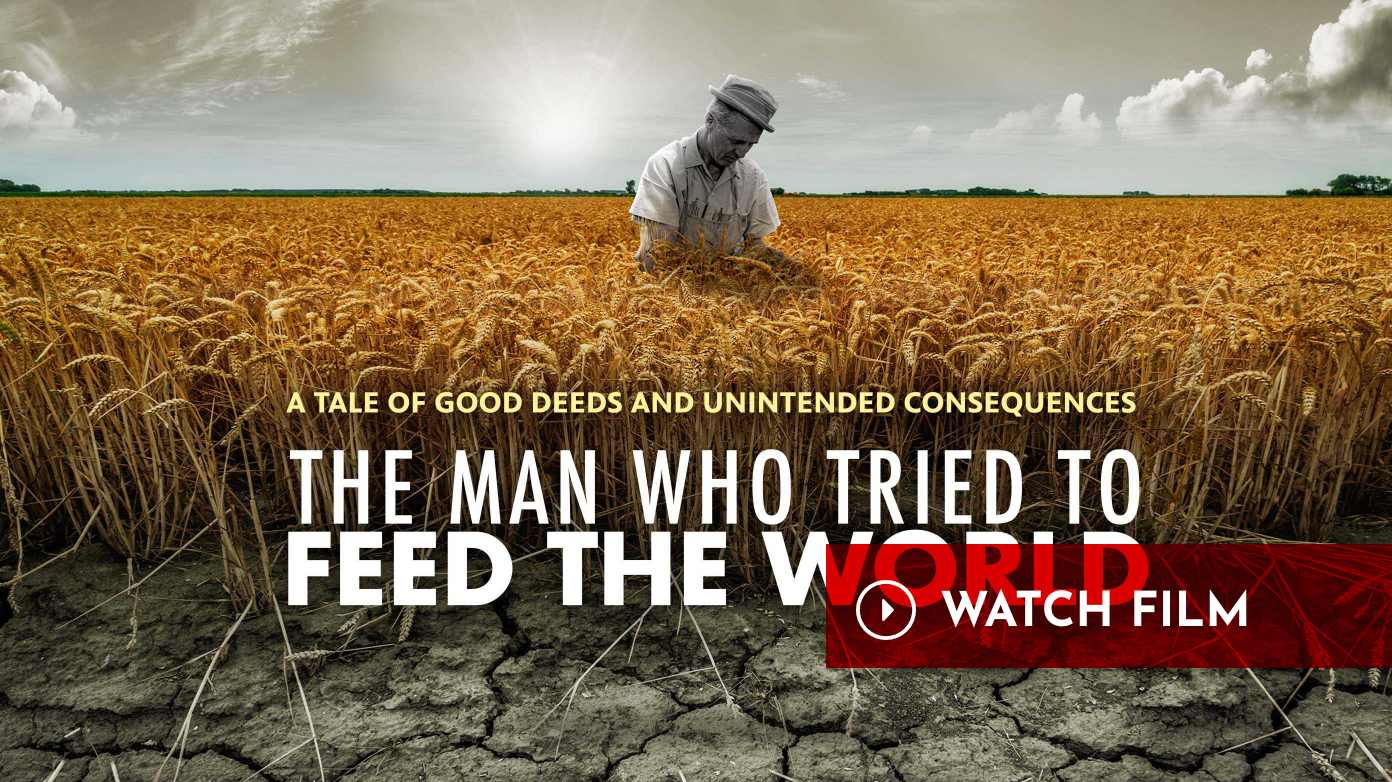Agricultural Literacy Curriculum Matrix
Lesson Plan
The Green Revolution
Grade Level
Purpose
Evaluate the agricultural advances of the Green Revolution, discover the contributions of Norman Borlaug, and discuss the impacts of this era from an economic, social, political, and environmental perspective by watching the 2020 PBS film, The Man Who Tried to Feed the World. Grades 9-12
Estimated Time
Materials Needed
Engage:
- Early Influencers slide deck
- Early Influencers clues page, 1 copy per student
Activity 1: ESPeN Impacts
Activity 2: The Man Who Tried to Feed the World
- The Man Who Tried to Feed the World, PBS documentary
- The full documentary is available for rent or purchase on Amazon Prime.
- Green Revolution Decision Matrix handout and teacher key
Evaluation:
- ESPeN Impact Circles (from Activity 1)
- ESPeN Impact Statement cards, 1 copy per class
Vocabulary
Green Revolution: beginning in the mid-20th century, a large increase in crop production in developing countries achieved by the use of fertilizers, pesticides, and high-yield crop varieties
selective breeding: process by which humans control the breeding of plants or animals in order to exhibit or eliminate a particular characteristic
Did You Know?
- Between 1960 and 2000, yields for all developing countries rose 208% for wheat, 109% for rice, 157% for maize, 78% for potatoes, and 36% for cassava.1
- The Green Revolution was used as a tool to help fight communism in the Cold War by decreasing rural poverty and hunger because "no one becomes a communist on a full belly."2
- The inventions of the Green Revolution turned the United States from an importer of wheat to an exporter of wheat.3
- India Rice 8, known as IR8 changed so many lives in India by preventing famine that some parents named their sons after this variety of rice.3
Background Agricultural Connections
Following the wars of the 1940s, food was scarce in many parts of the world. There were famines and droughts along with growing numbers in the world population. These world events presented a need to produce more food for a hungry world. The Green Revolution took place between 1950 and the late 1960s. It is a period of time that research and technology increased agricultural production to address hunger and food insecurity.
Norman Borlaug was a key leader and is now known as the "Father of the Green Revolution." Borlaug was an agricultural scientist whose goal was to eliminate hunger. He used selective breeding practices to develop a variety of wheat that resisted a devastating disease called stem rust. His new wheat varieties also produced more grain per plant and were shorter than previous varieties making them less susceptible to wind damage. In addition to the high-yield wheat variety, Borlaug also researched the use of synthetic fertilizers, irrigation, and pesticides to dramatically increase the final harvest.
The Green Revolution contributed to a reduction of poverty, averted hunger for millions, raised incomes in some places, and reduced land use for agriculture. Norman Borlaug was awarded the Nobel Peace Prize, the Presidential Medal of Freedom, and the Congressional Gold Medal for his work. While the positive benefits of the Green Revolution are evident, some critics have raised concerns about the environmental and economic impacts of the agricultural practices Borlaug developed. While wheat harvests more than doubled, the inputs of soil nutrients (synthetic fertilizer) and water were greater.
Studying the Green Revolution gives students an opportunity to evaluate from these agricultural innovations from a social, economic, environmental and political perspective to recognize the complexity of feeding the world.
Engage
- Display slide number one of the Early Influencers slide deck.
- Ask students if they recognize any of the individuals numbered 1-10. Write any guesses on the board.
- Display the second slide of the Early Influencers slide deck that includes each of the individuals’ colored photo “badge” next to their photo. Explain to students that these badges give a hint for how that individual has influenced or impacted society (then and now). Determine if any of the badges help students identify these individuals. Include additional guesses on the board as you go.
- Pass out an Early Influencers clues page to each student or pair of students.
- Allow students to match each of the photos on the board with the clues on the page by writing the number next to the clue.
- Reveal the answers to students using slide number three.
- Allow students to write the names of each person next to their clue.
- Ask students to consider how these individuals impacted and influenced society. Consider the following questions to lead a class discussion:
- If this person did not accomplish what they did, and we didn’t live with their influence, discovery, or invention today, where would we be?
- Can someone’s positive influence, invention, or discovery also have a negative impact? Why or why not?
- Explain to students that we will focus on one of these individuals whose innovation and work had tremendous positive impacts globally, but also faced extreme criticism.
- Ask students, “Who do you think this is?” (Norman Borlaug)

Explore and Explain
Activity 1: ESPeN Impacts
- Prior to class, print out the ESPeN Impact Circles on separate sheets of paper.
- Hang up each of the circles on the board in the following order: Economic, Social, Political, and Environmental (ESPeN). Teach students the ESPeN acronym so they can better remember each impact.
Teach with Clarity
This lesson uses a teaching strategy that allows learners to investigate economic, social, political, and environmental (ESPeN) impacts concerning innovations or events. This strategy provides learners with an opportunity to evaluate issues and consider different points of view. The ESPeN strategy is a useful strategy for investigating complex and controversial socioscientific topics.
- Explain to students that when discussing historical events, discoveries, inventions, revolutions, or movements, there are four different impacts to consider. (Economic, Social, Political, and Environmental.) What are the economic impacts of a particular discovery? What social impacts did it have? What political impacts came from this movement? Did a movement positively or negatively impact the environment?
- Ask students to consider the following questions:
- Is it possible for something to have a positive impact in all four ESPeN categories?
- Are there ocassions when an impact can be positive in some areas and negative in others?
- Can you think of an event in history that has had both positive and negative impacts?
- Refer to the early influencers from the Engagement section of the lessons. Draw upon students’ prior knowledge of those discoveries, movements, or historical events and help them practice identifying ESPeN impacts from the discovery of pasteurization, genetics, refrigeration, vehicles, new agriculture practices, and technology advancements. Examples include:
- (Economic) Refrigeration allows cattle and other livestock to be harvested and processed closer to where they were grown rather than driving cattle to the markets like they did in the 1850s.
- (Social) Pasteurization of milk nearly eliminates foodborne illness from milk.
- (Social and Political) The invention of the cotton gin created more demand for cotton which was primarily grown by enslaved African Americans leading to the Civil War.

Activity 2: The Man Who Tried to Feed the World
- Introduce the film using the title, subtitle, and the descriptive paragraphs on the film webpage. Ask students what questions arise in their minds as they hear/read the introduction to the film. Some questions may include:
- What are unintended consequences?
- How did Norman Borlaug solve India's famine problem?
- Why would Norman Borlaug's achievements come 'under fire'?
- Introduce a Decision Matrix as a tool designed to help evaluate multiple criteria along with the importance, or weight, of each criteria to ultimately make a decision.
- Pass out the Green Revolution Decision Matrix handout. Discuss the first page and call out the the ESPeN (economics, social, political, environmental) model that they will be using to evaluate the work of Norman Borlaug who is known as the "father" of the Green Revolution.
- Prior to watching the film, students should indicate a "weight" for each ESPeN category. They should circle "1" for the factor they feel is most important, "2" for the next factor, and so on.
- Watch, "The Man Who Tried to Feed the World." Available for rent or purchase on Amazon Prime. Instruct students to take notes on their Decision Matrix as they watch the film.

- Following the film, instruct students to review their notes and the "weight" they indicated for each ESPeN factor. They should then answer the question, "Were Norman Borlaug's efforts successful? Why or why not?" on a sheet of paper. See the teacher key to help guide discussion.
Evaluate
- With the ESPeN circles still on the board, distribute one ESPeN Impact Statement card to every student or pair of students.
- Ask students to review their card and determine which category the impact falls under (economic, social, political or environmental). They should attach the card to the board under the impact circle with a magnet or tape.
- As a class, use the cards to discuss the benefits and challenges that developed from the Green Revolution.
- Review and summarize the following key concepts:
- The scientific and agricultural discoveries made by Norman Borlaug saved countless lives from starvation and averted additional famine that was predicted in the 1960s.
- Due to his advances in plant breeding, Norman Borlaug is considered the "Father of the Green Revolution."
- Governments are concerned about food security and hunger. Hunger is usually associated with political unrest. Governments have an interest in securing a sufficient food supply.
- The discoveries of the Green Revolution gave farmers tools to provide more food for a growing population. There were benefits as well as environmental impacts and social challenges.
- While many positive benefits came from the Green Revolution, they were not experienced equally by every country due to differences in infrastructure, political influence, and education to diffuse new ideas and practices.
Sources
Recommended Companion Resources
Author
Organization
| We welcome your feedback! If you have a question about this lesson or would like to report a broken link, please send us an email at matrixelearning@gmail.com. If you have used this lesson and are willing to share your experience, we will provide you with a coupon code for 10% off your next purchase at AgClassroomStore. |
